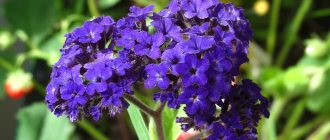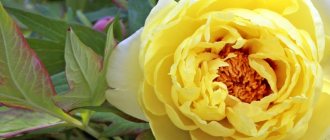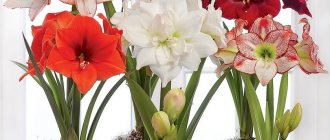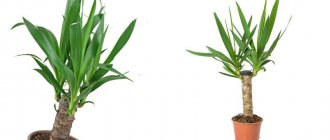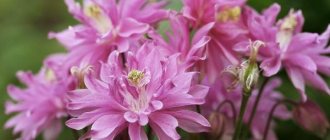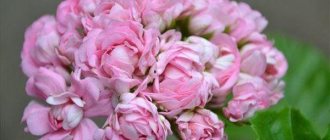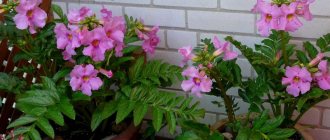The unusual flowers of hippeastrum on a high peduncle will not leave indifferent even those who are not keen on flowering plants. Although it is often confused with amaryllis, they belong to different genera of the same family.
The unusual flowers of hippeastrum on a high peduncle will not leave indifferent even those who are not keen on flowering plants
Botanical description of hippeastrum
The name of the bulbous plant (Hippeastrum) of the Amaryllidaceae family is translated into Russian as “horseman” and “star”. The shape of the bulb is round, with a diameter ranging from 5 to 10 cm. The surface of the linear leaf plates is grooved, the lower part is keeled. They grow up to 70 cm in length and up to 5 cm in width. Usually colored green, but there are varieties with a purple color.
The leafless peduncle is decorated with an umbrella-shaped inflorescence with orange, pink, white, dark or bright red large funnel-shaped or tubular flowers.
Reproduction
Hippeastrum reproduces in three ways: by children, by seeds and by dividing the bulb.
Advice! Seed propagation of plants is preferable in a breeding program and is associated with some difficulties in collecting, pollinating and germinating seeds.
At home, growing hippeastrums is best done by children. If your plant has produced babies, it’s time to replant it, separating the babies from the mother bulb. To ensure successful propagation, choose children at least 2 cm tall and with a good root system. However, remember that they will bloom only after 4 years.
Hippeastrum morelianum tolerates environmental conditions well and is suitable for growing in the garden
Propagation by bulbs is a complex process that requires care and patience. When separating young bulbs from the mother bulb, it is important not to injure them and not to introduce infection into the main bulb.
Important! Bulbs should not be taken for propagation during or immediately after the plant blooms.
The separated bulbs are washed well, cleaned of dried scales and a complex operation is carried out to cut them into segments. First, cut the onion into 5-6 segments, then these segments are cut into 3-4 parts, two scales on each. So they are planted in prepared soil made from river sand, perlite, sawdust and peat.
Large bright hippeastrum flowers in summer can brightly decorate the terrace, gazebo or balconies of your home
Catalog of types and varieties of indoor and garden hippeastrum
Thanks to breeders, 90 species, as well as more than 2,000 varieties and hybrids of this bulbous plant, were created by crossing.
Hippeastrum with red flowers is the most popular because it can lift your spirits in winter. The variety of varieties has led to the creation of garden classifications that differ in the shape and color of flowers. Some of them are grown indoors, while others are grown in open ground.
We also recommend reading:
16 most popular indoor plants Physalis: description of species and varieties, technology for growing from seeds Spruce in landscape design: the best ornamental varieties and characteristics of cultivation Kalanchoe: description of types and characteristics of care at home
There are several methods to catalog a bulbous plant:
- Flower size.
- The amount of overlap of the petals with each other.
- Similar to orchids.
- Structure (terry and non-terry).
The most successful is the hippeastrum with red flowers.
Breeders classify the size of the buds into 3 main groups:
- Small-flowered.
- Large-flowered.
- Medium flowered.
Depending on the direction of selection, classification occurs into the following varieties:
- Tubular;
- Leopoldia;
- Terry;
- Belladonna;
- Miniature;
- Regina;
- Orchids.
Hippeastrum Lady Jane
Lady Jane
It is considered the most delicate species with flowers up to 20 cm in diameter with wavy edges. Peach color. The corrugated surface has yellowish-pink veins.
Barbados
It is one of the brightest representatives of hippeastrum, having red-burgundy flowers, in the center of which there are white lines.
Hippeastrum Barbados
Papilio Butterfly
It is distinguished by the elongated structure of the bulb. The appearance of the buds is similar to soft cream or greenish-yellow butterflies with red lines located in the central part of each petal. It was this similarity that formed the basis for the name of the variety.
Spotted
The petals are covered with small red speckles. The rest of the area has a greenish and creamy color.
Types and classification
Let's start with the fact that although the plant belongs to the amaryllis family, calling it amaryllis is a mistake. Hippeastrum has a hollow peduncle and 6-7 inflorescences, amaryllis has a non-hollow peduncle and 6-12 inflorescences. Back in 1954, after much scientific debate, the International Botanical Congress recognized the only wild African species as amaryllis - Amaryllis the Beautiful. The natives of South America were classified as hippeastrum, and the prefix “hybrid” was introduced for the name of the varieties.
A delightful combination of white and deep pink: a composition of hippeastrums in a vase among decorative candles
Velvet deep color of hippeastrum “Queen of the Night”
Later, a classification of hippeastrum was developed, based on the origin, timing of flowering, shape and size of the flower. It includes 9 groups of plants. First of all, these are hybrids:
- with long-tubular flowers
- with hippeastrum Regina (Reginae)
- c Amaryllis belladonna
- with orchid flowers
- Leopold hybrids
- miniature-flowered
- with double flowers
And
- wild species, actively cultivated
- hybrids and varieties not included in the previous 8 groups
Only good specialists can understand such diversity; it’s better for us to simply understand what kind of hippeastrum flower we would like to see on our window.
Variety of hippeastrum varieties
Artificially bred Hippeastrum Charisma
Planting hippeastrum
Purchasing planting material is not difficult, since bulbs are available in almost all flower shops. Before purchasing, it is recommended to carefully examine the bulbs so that they are not damaged, otherwise additional time will be needed for their treatment or the hippeastrum will die altogether.
Timing and technology for planting hippeastrum at home
Since the best time for forcing indoor flowers is autumn or spring, it is advisable to purchase bulbs at this time. Most often, mixes of bulbs are sold in retail outlets.
The purchased planting material is already prepared for flowering. The required steps are as follows:
- Initially, you need to select a suitable container, which should be narrow but tall.
- Filling the planting pot with suitable soil, which can be purchased at the store or made independently from turf soil, humus and sand.
- Deepening the bulb 2/3 of the way.
The pot should be placed in a place at room temperature. You don’t need to water the soil until the sprout appears.
Preparing hippeastrum for winter (video)
When and how to plant garden hippeastrum correctly
The beautiful flowers of hippeastrum fascinate many gardeners, forcing them to purchase this plant. Regular flowering is possible only with proper implementation of all the features of caring for it.
Before planting the bulbs on the site, they require special preparation (forcing). To do this, in the fall it should be placed in a dark place with a low temperature. The so-called hibernation lasts up to three months. Watering is not required at this time. Except for the danger of the roots drying out. In this case, you need to water a little.
With the onset of spring, when the threat of night frosts disappears, the material must be planted in open ground. First, the peduncle appears and the flower blooms. To avoid the plant wasting energy on forming seeds, the faded bud must be cut off along with the peduncle. After this, leaves begin to grow and babies appear on the bulb. Before the onset of autumn frosts, the bulb must be dug up and sent for forcing. Garden hippeastrum loves nutritious and loose soil.
What diseases and pests lie in wait for hippeastrum?
Hippeastrums can be affected by scale insects, mealybugs, thrips, onion and tuberculate hoverflies, onion mites and nematodes. If pests are detected, you need to treat the plants with an insecticide solution; if the infection is in the initial stage, then you can use folk remedies.
Of the diseases for hippeastrum, as for many bulbous plants, stagonosporosis (red burn) is especially dangerous. Infection can be recognized by the appearance of various red growths (spots, stripes, cracks) on all parts of the plant. The leaves begin to dry out and fall off, as a result of which the bulb becomes depleted and dies.
The disease is provoked by waterlogging of the soil, high humidity in the room, lack of ventilation, deepening of the bulbs and excess nitrogen in the soil.
Treatment of red burn in hippeastrum begins with removing the plant from the pot, all infected scales and roots are removed, dried and damaged leaves must also be removed, and the remaining ones must be shortened by half. The bulb needs to be soaked for several hours in a fungicide solution, dried and planted in new soil, leaving most of it on the surface. In the first few weeks after planting, watering should be minimal and water should not get on the bulb.
Gallery: hippeastrum (53 photos)
Features of caring for garden hippeastrums
In the warm season, the plant can be planted in open ground so that it can rest and gain strength. This crop tolerates sunlight well, but it is better to plant it in a place with openwork shade. In addition, the soil on the site must be well-permeable to moisture to avoid stagnation.
Although the plant does not require special care, it is important to ensure that no weeds grow nearby and remove them in a timely manner. The soil needs to be loosened regularly to prevent a dense crust from forming.
The distance between the bulbs should be at least 15 cm, and 5 cm between the children is enough. The bulbs must be buried in such a way that they protrude 1 cm above ground level. If the weather is moderate, you should water once a week. During hot days, increase watering by 2 times.
The process of caring for hippeastrum includes two main states - the flowering period and hibernation, which preserves the plant until the next flowering. Given the characteristics of the bulbous flower, it does not require significant effort.
Transplanting a plant
An adult hippeastrum is replanted in the spring every 3–4 years, when it stops blooming. Young plants undergo the procedure annually.
A new container is selected in such a size that the flower bulb is located 2 cm from the wall of the pot. Drainage is placed at the bottom, which is covered with a mixture of turf soil, peat, humus and perlite.
Since hippeastrum is very sensitive to transplantation and can get stressed, the procedure is done using the transshipment method. To avoid injury to the root system, the soil is thoroughly moistened and the pot is turned on its side. Lightly tapping the material , the soil ball with the flower is carefully removed from the old pot and transplanted into a new container. A third of the bulb should be located above the surface of the substrate.
